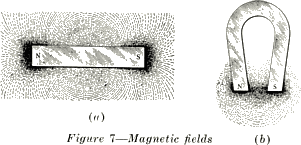of soft iron; but, if the rod is of hardened steel, the little magnets will remain more nearly
in the position shown in Figure 6 (b), after the flow of current has been stopped. It takes
a stronger current to produce a magnet of the same strength using a hardened steel rod
than it does if a soft iron rod is used, but hardened steel retains its magnetism after the
magnetizing current is stopped. This leads us to believe that it is more difficult to change
the position of the little magnets in hardened steel than in soft iron.
If iron filings are sprinkled on the surface of a sheet of paper placed directly over a
magnet, the filings will arrange themselves in a pattern similar to that of Figure 7 (a). If
the rod is bent into the shape of a horseshoe, we have what is called a horseshoe
magnet, and the pattern formed by iron filings over such a magnet will be as shown in
Figure 7 (b) . It will be noticed that the iron filings arrange themselves in curved lines
connecting the north and south poles of the magnet, and that the lines of the horseshoe
magnet are concentrated within a small area. These lines represent lines of force which are assumed to exist between the poles. Figure 7

shows that the
lines of force are more numerous and more concentrated when the poles are close
together. If a piece of soft iron is placed between the poles, touching one pole but not the
other, so as to reduce the air gap between them, the lines of force in the gap will be still
further increased. This shows that the number of lines of force varies with the air gap
between the poles, and the number of lines of force increases as the air gap is made
smaller. In other words, the iron serves as a path of low resistance for the magnetic lines
of force as compared with the resistance offered by air. This can be shown more readily by
passing a current through a coil of wire and noting the strength of the magnetic field
produced, and then noting the increase of the strength of the field when an iron rod is
inserted through the coil.
It should also be noted that the coil of wire, without the iron rod through it, behaves
exactly like an iron magnet in attracting the needle of a compass when an electric current
from a battery passes through the coil. It is important to have a fairly good idea of
magnetic lines of force because this property of magnetism will be referred to repeatedly
in later discussions.
3
